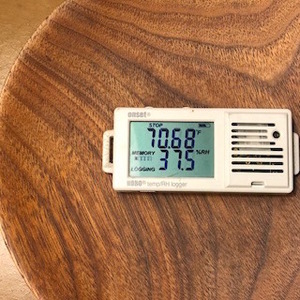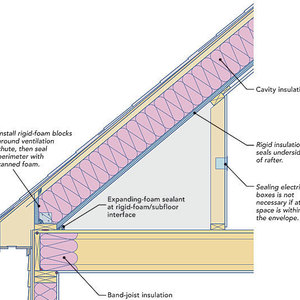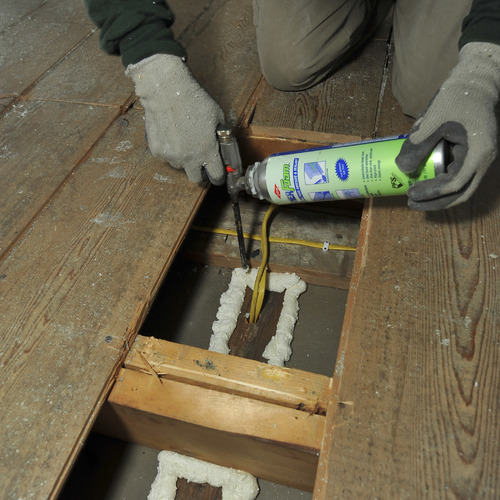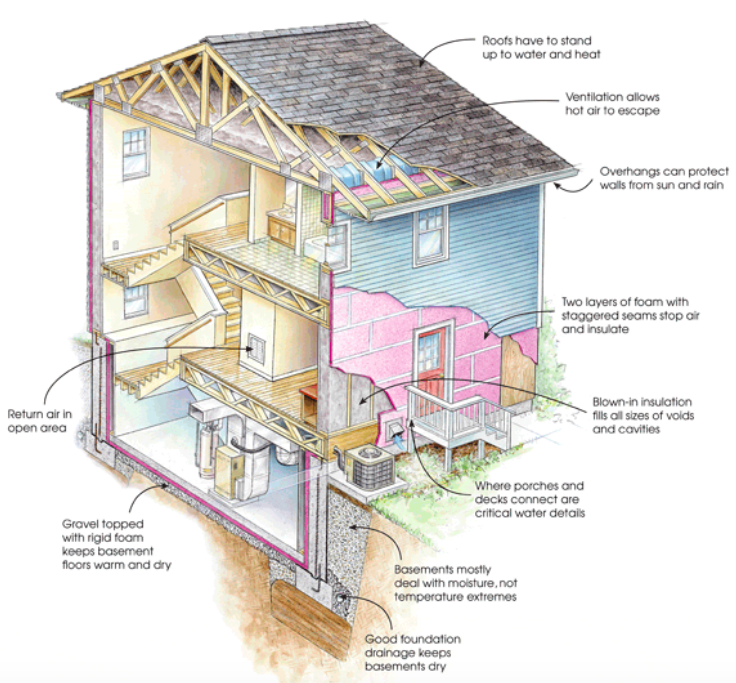
Slateandall (let’s call him Slate) has got his hands full. Writing from southern Connecticut, Slate describes his 1910s Tudor-style home as more or less of a train wreck from a performance point of view.
The house, according to Slate’s recent Q&A post, has no insulation to speak of and an aging gas boiler. Indoor air is high in humidity in the summer with heating costs running between $4000 and $5000 a year.
“The first thing we did energy-wise was install a minisplit system for the southern half of the house (all three levels) so we can survive the summer while figuring out what else to do,” Slate writes. “It makes the whole house livable, with the help of a couple window units.”
Then Slate brought in an energy consultant who developed a comprehensive plan. It included insulating and sealing the attic with R-49 loose fill on the attic floor, air-sealing the entire house, installing a “big dehumidifier” in the basement, and installing a minisplit to heat and cool the rest of the house.
The estimated payback for this work is 15 years, but that doesn’t include the additional minisplits.
“I have so many questions I don’t know where to begin,” Slate says. Should he skip the insulation and just install the minisplits? Will an insulated attic be too hot in the summer? Should he put a fan in the attic to keep it cool? Does it matter if the basement is humid? How to insulate the original slate roof is another issue.
In other words, what now? That’s where we begin this Q&A Spotlight.
Insulate and seal the leaks
Michael Maines, both a builder and a residential designer, recommends that Slate make sure the building enclosure is well insulated and air-sealed before he pulls…
Weekly Newsletter
Get building science and energy efficiency advice, plus special offers, in your inbox.

This article is only available to GBA Prime Members
Sign up for a free trial and get instant access to this article as well as GBA’s complete library of premium articles and construction details.
Start Free TrialAlready a member? Log in















2 Comments
Slate start with sealing/insulating and de humidification. I bought an old 5,000 square foot house here in Virginia back in March of this year and am dealing with a lot of similar issues. The oldest part of the house is at least 80 years old, and it was added on to 4 times. It was a general store/souvenir shop/etc and served as a residence as well. The house has an amazing view that overlooks a valley, and you can see for miles which is why we bought it fully aware of its issues. The house has a new roof, standing seam and asphalt shingles and a new heat pump/with oil back up. Electric bills average $225-$250 per month. The first thing I did was seal up as many of the air leaks as I could. Weather stripping and spray foam. The three sets of old wooden double doors had huge gaps. The gaps around the ceiling in one room were ½”-1” and we were losing a ton of heat to the uninsulated attic that had both a gable and ridge vent. The old AC window units that did not work were still in the walls and might as well have been and open window, pulled all the units from the wall's, covered with plywood, and insulated the wall between the plywood coverings with Rockwool. I did all this in the first two weeks and that fixed a lot of the air leaks and improved the comfort in the house. The heat pump stopping running constantly as well I bought a $400 FLIR Thermal Imager and looked for more leaks and identified the worst spots and was happy to find areas that were much better than I thought without doing demo. I insulated the attic with blown in R60 cellulose after I fixed gaps and electrical issues that would be covered by the insulation. The blown in insulation was worth every penny and changed the comfort level in the area below the attic. The humidity in the house was an issue as I had both a dirt crawl space under one part of the house and basement in the other. In the basement area I put a whole house Ultra Air 120 pint dehumidifier and tied it into the house duct work. I used the 6” fresh air duct option to dehumidify the basement while the other ducts took care of the house. The house humidity went from 70% to 40-45% and is much more comfortable. I now run the AC at 77 instead of 72. Without going into a ton of details here is the site that explains it Installing a Whole-House Dehumidifier the Right Way | PV Heating & Air (pvhvac.com). I know this has been covered by Fine Home Building and Green Building advisor. For the crawl space I installed an AloAir 90 pint dehumidifier with a built in pump. Hung it from the joist with their pulley system and added the remote reader. Crawl space went from 85% humidity to 60% humidity and that is without encapsulation, just sealed all the vents and gaps. I will be insulating the crawlspace and basement walls with rigid foam and doing all the necessary sealing and insulating for the rim joists and other areas that need attention. More insulation is planned for the knee wall areas on the second floor after I complete some other work and make sure all the duct work is sealed before burying it in R-60 cellulose. I did like you and added some window units to offset cooling on the really hot days until I have a final solution on the number of mini split units that are needed once all the insulation is done. The investment in the window units was money well spent. It solves a problem for the short term, and they are easily passed on to others who need cooling. In closing I will be adding solar to the house this fall to cover 100% of my electric use including charging my Nissan Leaf and future electric vehicles. Hope this helps.
I would be interested in a breakdown of how this statement was conceived: "A 15-year payback is comparable to a 7% simple return on investment."
Log in or become a member to post a comment.
Sign up Log in